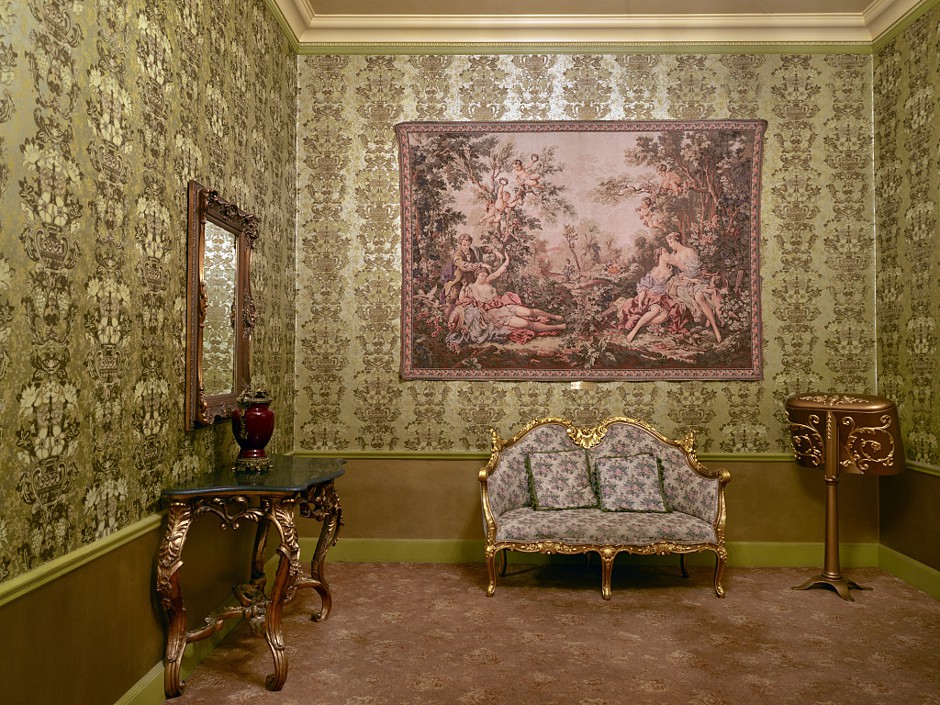
The opulent anteroom to a ladies' restroom at the Ohio Theatre, a 1928 movie palace in Columbus, Ohio. Carol M. Highsmith/Library of Congress.

Toilet with cistern, bracket, chain, and black walnut seat, circa 1880. Photo by Bettmann/Getty Images.
Separate Spheres
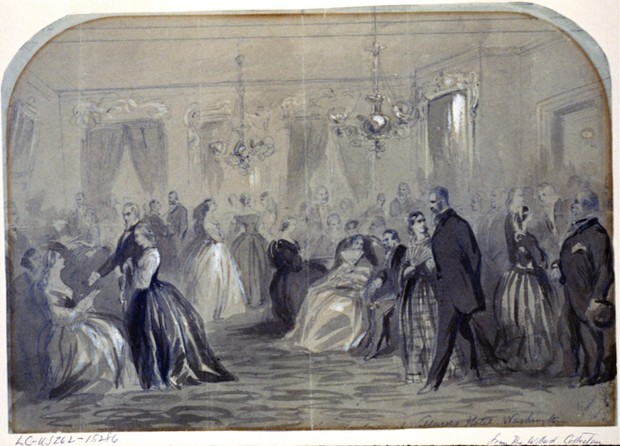
The ladies’ parlor at the Willard Hotel in Washington, shown during Inauguration Week in 1861. Presumably, men were welcomed inside during an inauguration party. Photo from the Library of Congress.
“The challenge to Rogers was in, part, that he had to make this building sort of supportive of commerce, which was developing in Boston,” Kogan said. “On the other hand, he was caught in the shadow of the separate-spheres ideology, and what he decided [to do] within the Tremont House was to create spaces that were sex-segregated.” Rogers created rooms exclusively for men and for women, including separate parlors and a library and a billiard room for men.
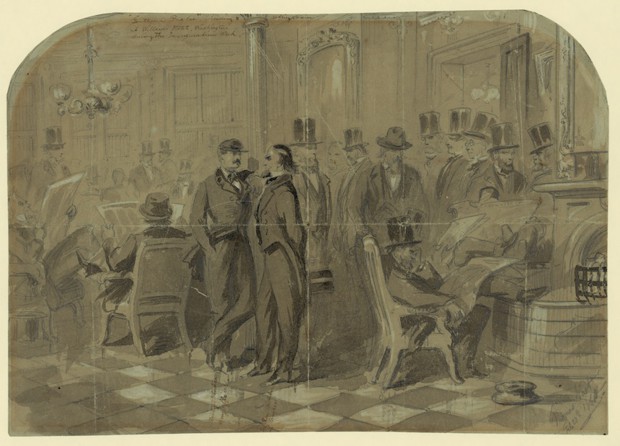
The gentlemen’s parlor, reading, and sitting room at the Willard, also shown during 1861’s inaugural celebrations, with no women visible. Photo from the Library of Congress.
“The significance of that, in my view, cannot be overstated,” said Kogan. “Rogers and the investors … were basically tipping their hats to the separate-spheres ideology, while creating spaces in the public realm for women to become active consumers in the 19th-century economy.”
The Tremont House was also the first major building in America to have indoor plumbing, with a bank of eight water closets on the main-floor hallway, each designed for a single user. Rogers felt no need to designate them by gender, because like the outhouses they were based on, they were single-user only.
Plumbing and sewage technology didn’t enable toilets to move indoors in greater numbers until roughly the 1850s, and at that point, some architects decided that water closets should follow the lead of the gender-designated parlors. So they placed single-user water closets in the spaces that were set aside for women. In public libraries, for instance, they would put a single-user water closet off the women’s reading room. “That is, by default, a sex-designated toilet, even though it’s single-user, because only women go into that space,” Kogan noted.
By the 1860 and 1870s, plumbing technology had advanced to the point of facilitating multi-user restrooms. Then, when luxury buildings like hotels, theaters, and department stores added multi-user, gender-segregated restrooms, architects continued the separate-spheres pattern, creating public spaces that imitated the home. It’s at this point that we start seeing women’s restroom lounges emerge.
Comfort Stations and Emergency Rooms
These rooms typically featured couches where women—perceived to be more fragile—could rest and regroup. Most men’s restrooms from this era did not have an equivalent space. Some did have adjacent rooms, but these were more about socializing than providing somewhere to rest.
In addition to hotels and theaters, department stores were early adopters of public restrooms and ladies’ lounges, primarily because the stores were designed to be daylong experiences, where women would spend hours shopping, getting their hair done at the on-site salon, eating at the restaurant, and resting when they needed a break.
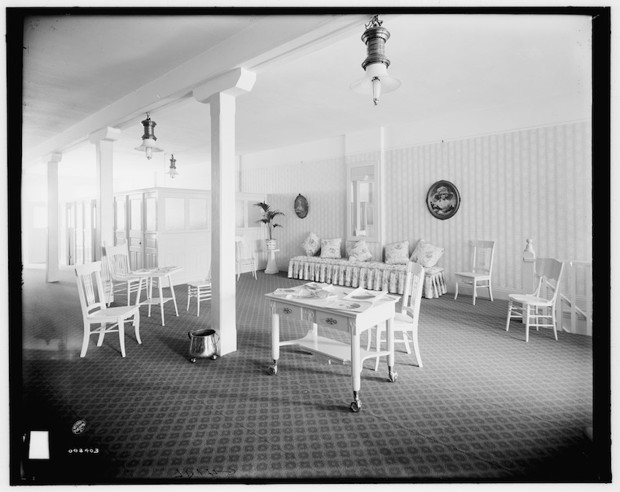
A women’s restroom with a couch and writing table at the E.M. Bigsby showroom in Detroit, circa 1900. Photo from the Library of Congress.
The women’s parlor at the Emporium in San Francisco offered visitors periodicals and stationery in addition to a place to rest. Similar impressive but no-longer-existing spaces could be found at Higbee’s in Cleveland, the Jordan Marsh Company in Boston, and at the “rest rooms” at Lansburgh & Bro. department store in Washington, D.C. Today, you can still find seating areas adjacent to the women’s restroom in many Nordstrom stores across the country, as well as at Bloomingdale’s and the St. Regis Hotel in New York City.
As Laura Walikainen Rouleau, a historian and author of the forthcoming book Private Spaces in Public Places, explains, increasing the availability of public restrooms in the late 19th and early 20th century was the goal of the “public comfort” movement. Public restrooms were often referred to as comfort stations.
In the 20th century, with more women entering the workforce during World Wars I and II, the rationale behind the lounges and the function shifted somewhat. Women were now in public more, but they still might want somewhere to relax, take a smoking break, or put on makeup—which was now mainstream after being stigmatized. It was not acceptable, however, for women to apply makeup in public. Lounges were outfitted with vanities and other mirrors so that women would have a place to touch up their cosmetics in semi-privacy.

American servicewomen chat and apply makeup in the powder room of a women’s military-services club in New York during World War II. PHoto by Bob Wands/AP.
Depending on who you ask, you’ll hear different terms used for a room with couches next to a room with toilets. As is the case today, there was no universal name for where people used the toilet in a public setting, or any adjoining rooms. Walikainen Rouleau says the seating areas for women were referred to as “retiring rooms,” “rest rooms” (as in a room specifically for resting), and even “emergency rooms.” The last term sounds bizarre today, but the rooms were partly intended as places where women could lie down if they were feeling sick or faint, or even wait for medical assistance to arrive. Of course, euphemisms such as “retiring room” avoided referring to the private physical activities of the women inside—not just going to the bathroom, but breastfeeding and menstruation.
It’s important to note that these lounges or parlors were, for the most part, for upper- or middle-class white women. Walikainen Rouleau says most of the examples she has found of women’s lounges or parlors in public spaces have come from the northern Midwestern parts of the United States. She has also found floor plans for standalone public-comfort stations in Texas, with divisions based on race: sections for white women and for black women; sections for white men and for black men.
“The white women’s sections are by far the most elaborate,” she said. “This is where the infants’ room with the sink in it is.” The white side of the station also had separate ladies’ and men’s parlors. “There really are not these spaces offered for African-American women.”
“I believe at this time that the middle-class portion of society viewed privacy as dependent on these social constructs … that women and their bodies and their activities needed to somehow be shielded, but especially white middle-class women,” Walikainen Rouleau said.
The Future of the Restroom-Plus
One of the reasons why restroom lounges are now scarce is because in the older buildings where they could once be found, they are often lost during renovations, converted into other types of space with more utility or potential for profit—such as a bar area in a theater, or more retail space in a department store.
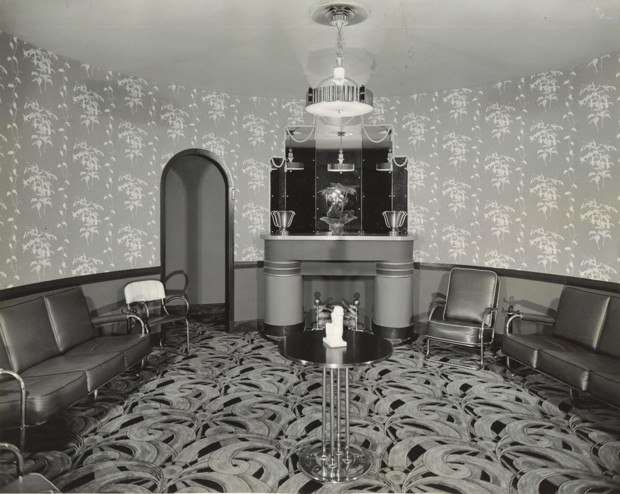
The women’s lounge at the Senator Theatre in Baltimore, shown in an archival photograph. Photo courtesy of Rob Holmes.
That didn’t happen at Baltimore’s iconic Senator Theatre, which reopened in 2013 after $3.5 million in improvements. Renovation architect Alex Castro says that in the early stages of the project, there was talk of whether the restroom lounges should stay, or, like so many others, be turned into more lucrative space. Ultimately, they stayed. “To get rid of them would be to get rid of one of the most important aspects of the theater itself,” Castro said.
When the Senator opened in 1939, even going to your neighborhood theater was an event. Moviegoers weren’t just looking to see the latest film—they wanted a glamorous Hollywood experience. At the Senator, the sophistication that patrons craved was expressed differently in the men’s and women’s restrooms and lounges. The men’s room was dark, with a wood-beam ceiling, a tile floor, and a fireplace. The women’s room, on the other hand, was “glittery and upbeat,” in Castro’s words—a circular, bright, carpeted room, with an area for applying makeup.
Other theater-restroom lounges that have survived renovations include those at Radio City Music Hall, the Shoji Tabuchi Theatre in Branson, Missouri, and the Los Angeles Theater, a gilded movie palace.
Although most new buildings don’t have dedicated lounge areas next to restrooms, some have “family rooms” that accommodate people who need to change a child’s diapers or breastfeed. Unlike their predecessors, these rooms tend to be nongendered, reflecting the shift toward a more inclusive concept of parenting. New initiatives like Stalled aim to pave the way for all-gender multi-user restrooms across America.
But the women’s-only lounge isn’t extinct just yet. The trendy Millennial women’s club The Wing has a “Personal Space” zone that includes a changing room, a nursing room, and a beauty room featuring a row of vanities and plush velvet chairs that wouldn’t look out of place in an Art Deco theater. The idea is no longer for women to hide out from the stresses of being in public—they don’t need an “emergency room.” But as they prepare to go out and meet friends or give a presentation at work, they can still appreciate a touch of old-school glamour.